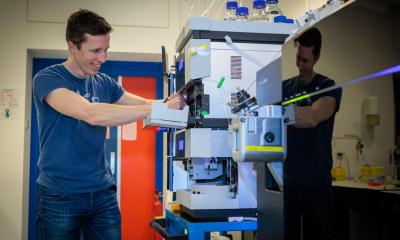How does the body process pain? Study sheds new light
Currently available pain medications have limited efficacy and numerous side effects. New research, however, provides deeper insights into how our bodies process pain, paving the way for an innovative, more effective way of targeting chronic pain.

According to recent estimates from the National Institutes of Health (NIH), as many as 25 million people in the United States live with daily pain, and 23 million of the country's adults have more severe pain. Chronic pain is defined as any pain that lasts for longer than 12 weeks, although in most cases of chronic pain, the discomfort lasts for months on end. The currently available treatment options for chronic pain aim to help the patients better manage the pain rather than "cure" it. To this end, medical professionals prescribe medication, electrical brain stimulation, or surgery. Commonly prescribed medications for pain management include two categories of drugs: nonsteroidal anti-inflammatory drugs (NSAIDs), such as aspirin or ibuprofen, or opioids, such as codeine or morphine. Both of these classes of medication can cause serious side effects, besides not always working. Opioids can cause addiction, especially if used over a longer period of time, and NSAIDs can lead to stomach ulcers and damage to the kidneys. For these reasons, people often turn to complementary or alternative medicine to ease their pain.
But now, researchers from Columbia University Medical Center in New York - led by Dr. Nigel Bunnett, Ph.D., a professor of surgery and pharmacology - have unveiled the mechanism behind chronic pain, in a study that could prove to be a game-changer for pain medication. "Previous efforts to develop more effective analgesics have been stalled by our limited understanding of the mechanisms that allow nerves to sense and transmit pain signals," Dr. Bunnett says. The new research - published in the journal Science Translational Medicine - reveals how pain occurs in a location that may be "hidden" away from the reach of widely available pain medication.
Pain medication and pain receptors
Some of the analgesics available target so-called G protein-coupled receptors (GPCRs) on the surface of the cell. GPCRs are a group of membrane receptors shared by humans, animals, plants, and even fungi. Their role is to receive information from the environment and pass it on to the cells. In the human body, GPCRs fulfill a wide range of functions - in fact, humans have almost 1,000 different GPCRs, attuned to very specific signals from the environment. So, the receptors are involved in almost all of the body's biological processes, including its response to pain.
As a result, between one third and 50 percent of all of the drugs available on the market work by targeting GPCRs. For instance, some pain medication works by activating opioid receptors, which are a kind of GPCR. There is an additional type of GPCR called the neurokinin 1 receptor (NK1R). When activated, this receptor causes pain and inflammation. New drugs that have attempted to target this pain receptor have been unsuccessful, however.
NKR1 pain receptor key in blocking pain
However, the new experiments carried out by Dr. Bunnett and his colleagues revealed that when activated by pain, NK1R tends to quickly shift away from the cell surface and into the endosomes of the nerve cells. Endosomes are small compartments inside a cell. When NK1R is inside an endosome, it can continue to cause pain and inflammation. Further experiments in rodents showed that attaching a fat molecule, or a lipid, to NK1R-blocking chemical compounds helps them to break through the membrane and into the endosomes, thus providing pain relief. "From these experiments, we have demonstrated that designing NK1R inhibitors that are capable of reaching the endosomal network within nerve cells may provide much longer-lasting pain relief than currently available analgesics. More than a third of all currently available drugs act on GPCRs in some way. We think that modification of many existing compounds, as we did with NK1R inhibitors, may have the potential to enhance the effectiveness of many different classes of medications", says Dr. Bunnett. Given the limitations of NSAIDs and opioids, the research done by Dr. Bunnett and colleagues could bring some much-needed innovation to existing pain-targeting medication.
Source: Medical News Today
05.06.2017











